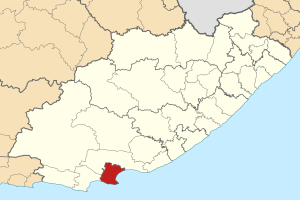Nelson Mandela Bay Metropolitan Municipality facts for kids
Quick facts for kids
Nelson Mandela Bay
|
||
|---|---|---|
|
Metropolitan municipality
|
||
| Nelson Mandela Bay Metropolitan Municipality | ||
|
||

Location in the Eastern Cape
|
||
| Country | South Africa | |
| Province | Eastern Cape | |
| Seat | Gqeberha (Port Elizabeth) | |
| Wards | 60 | |
| Government | ||
| • Type | Municipal council | |
| Area | ||
| • Total | 1,959 km2 (756 sq mi) | |
| Population
(2022)
|
||
| • Total | 1,190,496 | |
| • Density | 607.71/km2 (1,574.0/sq mi) | |
| Racial makeup (2022) | ||
| • Black African | 62.7% | |
| • Coloured | 19.2% | |
| • Indian/Asian | 1.2% | |
| • White | 15.7% | |
| First languages (2011) | ||
| • Xhosa | 53.9% | |
| • Afrikaans | 29.3% | |
| • English | 13.5% | |
| • Other | 3.3% | |
| Time zone | UTC+2 (SAST) | |
| Municipal code | NMA | |
The Nelson Mandela Bay Municipality is a large city area in South Africa. It is one of eight special city areas called "metropolitan municipalities." You can find it on the coast of the Eastern Cape province.
This municipality includes the main city of Gqeberha (also known as Port Elizabeth). It also has the nearby towns of Kariega (Uitenhage) and Despatch. The areas around these towns are also part of the municipality. The name "Nelson Mandela Bay" was chosen to honor Nelson Mandela, a famous former President.
Contents
History of Nelson Mandela Bay
The Nelson Mandela Bay Metropolitan Municipality was officially created on 5 December 2000. It was set up to manage the areas around Port Elizabeth (Gqeberha). This included the towns of Kariega (Uitenhage) and Despatch. It also covered the farming areas nearby.
Towns and Villages in the Municipality
When it was formed, the municipality brought together several towns and villages. These included places like Beachview and Bethelsdorp. Other important areas were Colchester and Despatch. It also included iBhayi, KwaNobuhle, and Motherwell. Finally, New Brighton, Port Elizabeth, Seaview, Swartkops, and Uitenhage were part of it.
People and Statistics in Nelson Mandela Bay
In 2011, about 1,152,115 people lived in the Nelson Mandela Bay Metropolitan Municipality. There were also 324,292 households, which are groups of people living together.
Who Lives Here?
According to the 2007 census, most people (60.4%) identified as Black African. About 22.6% were Coloured, and 16.1% were White. A smaller group (0.9%) identified as Indian or Asian.
Languages Spoken
Most residents (57.3%) speak Xhosa as their first language. Afrikaans is the first language for 29.7% of people. About 12.1% of residents speak English as their first language.
Religious Beliefs
Most people in Nelson Mandela Bay are Christian (89.4%). Some people (6.1%) do not follow any religion. Smaller groups include Muslims (1.5%), Jewish people (0.4%), and Hindus (0.3%).
Daily Life and Economy
About 16% of all households have only one person living in them. The average household has about 3.86 people. The average age of people living here is 26 years old.
The main part of the local economy is manufacturing, which makes up 33% of it. Community services also contribute a lot, at 27%. Tourism is also very important and creates many jobs. This is because the municipality has beautiful beaches. Four of these beaches have a special "Blue Flag status," meaning they are very clean and well-managed.
Access to Services
Everyone in Nelson Mandela Bay has access to water close to their homes. Most households (91%) have basic sanitation services. All homes in the urban areas have basic trash collection. Also, 97% of homes in official residential areas have basic electricity.
The municipality has many important services for its residents. There are 41 permanent and satellite clinics, plus 13 mobile clinics. It also has eight hospitals and 22 libraries. There are 31 community halls and 79 sports facilities. For fun, there are 19 beaches and 18 swimming pools. For education, there are 273 schools, one university (Nelson Mandela University), and several colleges.
See also
 In Spanish: Municipio Metropolitano de Nelson Mandela Bay para niños
In Spanish: Municipio Metropolitano de Nelson Mandela Bay para niños



